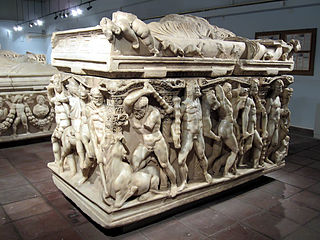
Parthenia was a Roman–Berber town in the former Roman province of Mauretania Sitifensis, the easternmost part of ancient Mauretania. It was located in what is now northern Algeria.

Oria is a town and comune in the Apulia region, in the province of Brindisi, in southern Italy. It is the seat of the Roman Catholic Diocese of Oria.

Apamea Myrlea was an ancient city and bishopric on the Sea of Marmara, in Bithynia, Anatolia; its ruins are a few kilometers south of Mudanya, Bursa Province in the Marmara Region of Asian Turkey.
Bergule or Bergula or Bergoule, also Bergulium or Bergoulion (Βεργούλιον), also called Bergulae or Virgulae, was a town in ancient Thrace, which was in later times called Arcadiopolis, Arcadiupolis, or Arkadioupolis (Ἀρκαδιούπολις). It was noted by Ptolemy, and inhabited during Roman and Byzantine times. Under the name Arcadiopolis in Europa it was the seat of a bishop; no longer a residential see, it remains a titular see of the Roman Catholic Church.
Arabissus or Arabissos, also known as Tripotamos, was a town in ancient Cataonia, then Cappadocia, and later in the Roman province of Armenia Secunda. The Byzantine Emperor Maurice was born there in 539. A cave of the Seven Sleepers is located in the Eshab-ı Kehf Kulliye.

Tiberiopolis was a town in the Roman province of Phrygia Pacatiana, mentioned by Ptolemy, Socrates of Constantinople and Hierocles. At various times, it was considered as part of Phrygia, Isauria, and the late Roman province of Pisidia.
Sidi El Hani is a town and commune in the Sousse Governorate, Tunisia located at 35.67n, 10.30e. As of 2004 it had a population of 3,058. It gives its name to the largest lake of the governorate, a natural salt lake or salt pan (sabkha) in dry seasons, the Sebkhet de Sidi El Hani which is shared with between one and two other areas depending on precipitation and its maximum extent forms the official boundary with part of a third, Monastir Governorate. The town is 30km south-west of the coast, its straightest connection being by Tunisian Railways, with a secondary connection by road, the P12 road which is a principal road to Kairouan from the A1 a few kilometres to the east. it is 19km from Kairouan and 26 km from Raqqada and.
Anineta, also known as Aninetum or Anineton, was a town of ancient Lydia or of Caria, and later of the Roman, and Byzantine empires, located in modern Turkey, the site of an ancient bishopric in and was an important site early in christianity. Anineta remains today a titular see of the Roman Catholic Church in the ecclesiastical province of Ephesus. In addition it minted coins bearing the legend Ἀνινησίων.

Satala or Satala in Lydia was a Roman era city and Bishopric in ancient Lydia.

Setae or Setai, or Settae or Settai (Σέτται), or Saettae or Saittai or Saittae (Σαίτται) was a town of ancient Lydia, located at Sidas Kaleh in Modern Turkey. The ruins of that town consist of a stadium, tombs and ruins of several temples. The town is not mentioned by any of the earlier writers, but appears in Ptolemy and Hierocles.
Tymandus or Tymandos also known as Mandos, Mandas Kiri, or Yassi Veran, was a Roman and Byzantine-era city in northern Pisidia. A number of monuments from Roman times remain in the area.
Reperi was an ancient Roman town of Roman North Africa, in the Roman province of Mauretania Caesariensis. The exact location of the ancient town is now unknown, but is surmised to have been in northern Algeria. The town seems to have lasted until the Muslim conquest of the Maghreb.

Marazanae was a Roman town of the Roman province of Byzacena during the Roman Empire and into late antiquity.
Isabelo Caiban Abarquez is the current serving Bishop of the Roman Catholic Diocese of Calbayog, Philippines.
Aegae or Aigai, or Aegaeae or Aigaiai (Αἰγαῖαι), or Aegeae or Aigeai (Αἴγεαι), was a town on the coast of ancient Cilicia, on the north side of the Bay of Issus. It is now separated from the outlet of the Pyramus by a long narrow estuary called Gulf of Alexandretta. In Strabo's time it was a small city with a port. Aegae was a Greek town, but the origin of it is unknown. A Greek inscription of the Roman period has been discovered there; and under the Roman dominion it was a place of some importance. Tacitus calls it Aegeae. It was Christianised at an early date, and while no longer retaining a residential bishop, remains a titular see of the Roman Catholic Church, under the name of Aegeae.
Ceretapa or Keretapa, also called Diocaesarea or Diocaesareia or Diokaisareia (Διοκαισάρεια), was a Graeco-Roman town of Phrygia Pacatiana. It minted coins bearing the demonym Κερεταπεύς. The coins also show that there was near it a river or fountain Aulindenus. It was a bishopric with Silvanus representing the city at the Council of Ephesus, 431. No longer the seat a residential bishop, it remains a titular see of the Roman Catholic Church.
Lupadium or Loupadion was a Graeco-Roman town of ancient Mysia. It minted coins during the Byzantine period. It was a bishopric; no longer the seat a residential bishop, it remains a titular see of the Roman Catholic Church.
Barate, Barata (Βάρατα), or Baratta (Βάραττα), was a town of ancient Lycaonia, on the road from Iconium to Tyana, 50 M.P. from the former. In some itineraria the name is also spelt Barathra. It was inhabited during Roman and Byzantine times.
Prymnessus or Prymnessos, or Prymnesus or Prymnesos (Πρύμνησος), was a town of ancient Phrygia, inhabited during Roman and Byzantine times. It was the see of a Christian bishop. No longer the seat of a residential bishop, it remains a titular see of the Roman Catholic Church.
Dioclea, Dioclia, Diocleia, or Diokleia was a town of ancient Phrygia, inhabited during Roman and Byzantine times.







